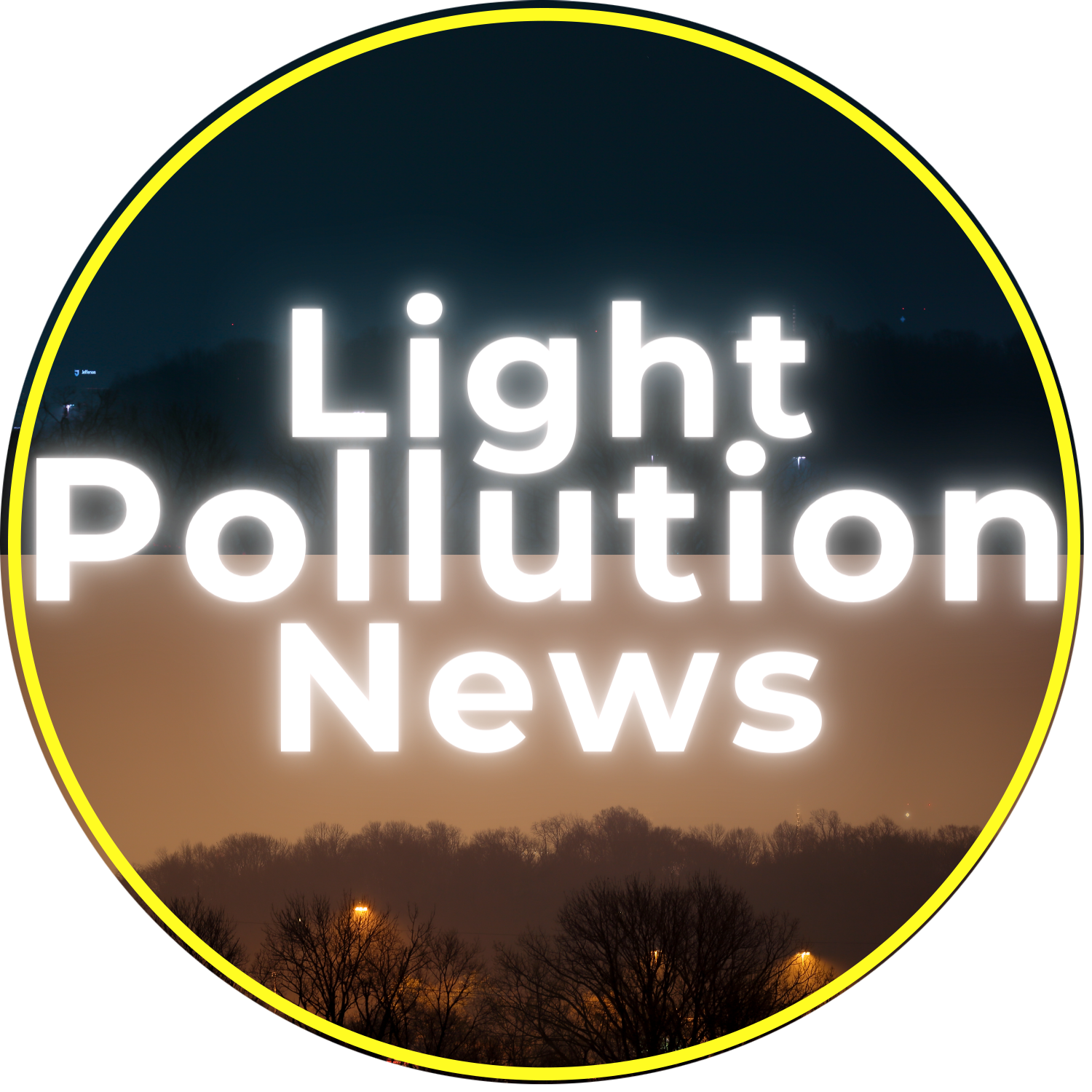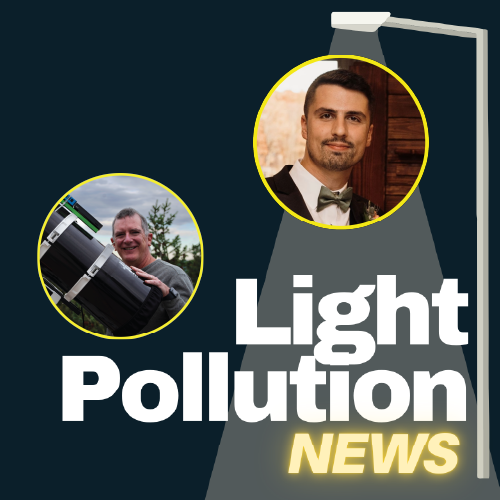
September 2025: 10 Point Scale!, Light Pollution News.
Join our mailing list. Follow us at LinkedIn, Instagram, Facebook, & Tiktok.
This Episode:
An interesting study looks at what happens when we frame the ideas around light pollution differently. More evidence for metabolism related disruption from light at night in circadian rhythms. And what is actually the biggest offender robbing us of vital sleep and our night sky!
I welcome back to the show, a dark sky advocate who’s helping to right the night outside of New York City, Mr. Steve Mariconda, and, just in time for some environmental talk, Mr. Frank Turina rejoins us!
A lot of good stuff in here today! Be sure to settle in, you’re going to like this one!
Like What You See and Hear? Consider Supporting the Show.
A hearty thank you to all of our paid supporters out there. You make this show possible.
For only the cost of one coffee each month, you can help us continue to grow. That’s $3 a month. If you like what we’re doing, if you think this adds value in any way, why not say thank you by becoming a supporter!
Why Support Light Pollution News?
- Receive quarterly invites to join as a live audience member for recordings with special Q&A sessions post recording with guests.
- Receive all of the news for that month via a special Supporter monthly mailer.
- The satisfaction that your support helps further critical discourse on this topic.
Support Light Pollution News!
Host:

Guests:


Steve Mariconda
Steve Mariconda, MPH, is a DarkSky Delegate and member of the New Jersey chapter. He educates the public about light pollution and responsible lighting practices. He recently received a Master of Public Health (MPH) degree from Rutgers School of Public Health and is the chair of the Saddle Brook Green Team. He is an outdoors enthusiast and musician.
Frank Turina
Frank Turina is an astrophotographer, night sky advocate, and environmental educator with more than 15 years of experience working with the United States National Park Service Night Skies Program. You can learn more about his examinations of the ecological and cultural effects of light pollution from his website, at the Night Sky Resource Center.
Full Article List:
- Finally! I Found Something That Actually Blocks Those Annoying LED Lights on My Devices, John Carlsen, CNET.
- Natural experiments from Earth Hour reveal urban night sky being drastically lit up by few decorative buildings, Scientific Reports.
- Light pollution from windows in buildings, Zenodo.
- Night lights versus conservation dreams: balancing human preferences with conservation goals in protected areas for sustainable nature-based noctourism, Journal of Sustainable Tourism.
- Fireflies: A Chinese story of love and loss, Liu Lican, Dialog Earth.
- Noise pollution and artificial light at night alter selection pressures on sexual signals in an urban adapter, Journal of Evolutionary Biology.
- Birds’ plight: Compromised cell-mediated immunity in response to ambient light pollution in redheaded buntings, Environmental Science and Pollution Research.
- All that glitters – Review of solar facility impacts on fauna, Renewable and Sustainable Energy Reviews.
- Framing exposure to excessive and improper lighting as light-public health, Discover Public Health.
- “External light schedules can induce nighttime sleep disruptions in a Homeostat-Circadian-Light Model for sleep in young children”, Tianyong Yao, Victoria Booth, Arxiv.org.
- Association between outdoor artificial light at night, circadian health, and LDL-C in intracranial artery atherosclerotic stenosis, Clinical Epigenetics.
- Effects of Air and Light Pollution on Brain and Behavioral Function: Potential Synergy, Neuroscience & Biobehavioral Reviews.
- On the Use of Lights as Night Navigation Aids During Antiquity, International Journal of Nautical Archaeology.
Light Pollution News, September Highlights:
Artificial Light Impacts on Wildlife
Research shows residential interior lighting can leak outside, with up to 225 lumens escaping through windows—around 15% of total light output—depending on window coverage and wall reflectivity. Nighttime lighting disrupts ecological systems worldwide:
- Fireflies in China are suffering due to habitat loss and celebratory mass releases for events, while their larvae are highly immobile and need stable environments.
- Urban artificial light at night reduces predatory threats but also diminishes mating opportunities for Latin American frogs.
- Just 2 lux of nighttime brightness (like a digital clock) can stress birds, lower immunity, and desynchronize breeding cycles in species like redhead buntings.
- Daytime light pollution is also a concern, with reflective solar panels confusing birds and insects (the “lake effect”), a problem being addressed by novel nanocoatings.
Public Attitudes and Terminology
A recent study of over 400 visitors to U.S. parks and arboretums found most participants would accept public lighting that favors both human utility and wildlife needs, reflecting a growing concern for environmentally sensitive lighting. Experts suggest replacing the term “light pollution” with “light at night” to reduce perception bias and better address related health and cultural implications, as the issue extends beyond the environment to circadian health, safety, and accessibility.
Health Effects of Artificial Light
- Daytime and pre-bedtime light levels significantly affect children’s sleep cycles, with dim daylight or nighttime exposure leading to sleep disruptions.
- Satellite data and lab studies reveal that higher levels of outdoor nighttime lighting may hinder proper cholesterol (LDL-C) control, even after adjusting for habits, and melatonin may help partially counteract these effects.
- Both artificial nighttime light and air pollution disrupt circadian rhythms, causing neuronal damage and potentially increasing risks for neurodegeneration and cognitive decline.
Historical and Archaeological Context
Ancient navigation also relied on lighting—Greek and Mediterranean sailors used vases with slits to direct torchlight without spoiling their night vision, evidence for which dates back to the 14th century BC with an illuminated reach of about 50 meters. On land, harbors used fires, religious buildings, and towers as early representations of the lighthouse concept.
Light Pollution News, September Read Along:
How many of you have had this problem? You buy a new device, it can be a modem, a window air conditioner, heck, even an air freshener. And what does it come with?? An almost endless array of indicator lights – you have lights on the device itself, you have lights that sit inside the device that flicker on and off, and, just because I guess, you have lights on the actual plug connecting it to the wall – b/c somehow if the other lights were all off, you wouldn’t be able to figure out that, that device is actually not powered!
Well, lucky for me, lucky for you, John Carlsen at CNET took on the question of how to block these annoying, completely unneeded indicator lights. And wouldn’t you know it, there’s actually a cottage industry of light blocking stickers out on Amazon. Rather than simply say, going down to the hardware store, buying yourself electrical tape, and cutting the tape to the size it needs to be, you can purchase an array of pre-sized sheets of tape that can cover up most indicator lights. And an added bonus – they come in different colors to match the color of your device!
Now, there was this study in Nature that utilized Earth Hour data in one of the brightest places that I’ve ever been to, which coincidentally has really great food, that being the former democracy of Hong Kong. It looked at a myriad of data, including images, sky brightness measures, and survey data from 2011-2024.
During Earth Hour, researchers found that the sky dimmed by 50%, largely from LED billboards and metal halide floodlights. Decorative lights provided only a small percentage of the total sky brightening. Rather, it really was LED Billboards and flood lights that the study found led the way. As an addendum to this news story, there’s also a follow up that uses machine learning to pinpoint the exact sources of light pollution.
If you happen to be curious about how much the average residential interior lighting outputs into the general nighttime brightness landscape, look no further than this attempt to quantify that via Zendo. Salvador Bara estimates that interior lighting imparts upwards of 225 lumens outside, that’s roughly 15% of an indoor light’s lumen potential. Included in that model are estimates for window size and wall reflectivity. The more shades you have drawn down, the lower that number goes.
To put it in context, car headlights have upwards of 6000 lumens, streetlights tend to emit around 5500 lumens, and…wouldn’t you know, LED billboards have the potential to emit 18k lumens. Our good friend the LED billboard strikes once again!
I have a good article here that leads us into some ecology news. This comes from the Journal of Sustainable Tourism. Researchers surveyed people at Acadia National Park, Grand Teton National Park, and at an undisclosed college arboretum located somewhere in an urban area in the Mid-Atlantic region, which is somewhere between Virginia and New York. The study included 412 participants and asked questions focusing on three factors that influence people’s views on lighting. Those being the value they place on the natural night, their feelings and preferences, and the value they place on protecting the natural night environment/wildlife.
Now, the authors of the study claim that this sample represents a diverse population of individuals. However, I have a hunch that most people who enjoy gambling and the nightlife head to Vegas, while those who enjoy roughing it even a smidge head to Acadia or the Grand Tetons. I can’t speak to the validity of that assumption – maybe it’s completely false. It’s just a feeling I have!
Regardless, they found that overall, their sample was willing to accept lighting that benefits nature and doesn’t harm wildlife, and participants were in support of lighting that benefited both humans and the environment.
Off to the wonderful world of ecology! Now, I know we’ve spoken a lot about fireflies this summer. Consider this the closing chapter in the 2025 saga of fireflies…maybe, who knows – probably not, but I did want to include this article because it was really neat.
Did you know that China is home to 200 species of fireflies! Fireflies are embedded in the Chinese culture, celebrated in stories and literature. One such story referenced an individual who read by the light of fireflies he caught in a bag because his family couldn’t afford an oil lamp.
China has seen a dramatic reduction in fireflies. Of course, much of that involves urbanization and the topics we typically speak to on this show. However, the Chinese culture has also recently, say in the last twenty to thirty years, begun wedding and other celebratory traditions by capturing thousands of fireflies and releasing them in a grandiose display! In China, you can buy fireflies online, and I guess, then hope that some of them survive the journey to be released in time for your celebration.
Now, one thing that I was not aware of was that firefly larvae depend on one habitat for upwards of a year, with a range of around 500m max, or about 1/3 of a mile. So when habitat loss occurs, it can be very difficult for them to move on.
The group, “Keep the Fireflies Glowing,” notes that despite working to add 11 of their 200 firefly species to a government protected list, Chinese law offers very little protection, and apparently even less recourse to enforce such lists.
The good news – as China grows richer, more people are learning and visiting ecological areas just to see the fireflies. There’s also the domestication of firefly production for said events that may offer some greater protection in the long run.
From the Journal of Evolutionary Biology, Artificial Light at Night has been seen to reduce predatory threats to tungara frogs. But, in turn, reduces the number of female frogs that may wish to entertain male frog calls, thereby increasing sexual competition for a reduced number of females. In this case, the predator was the fringe-lipped bat. These animals are native to Latin America, and researchers believe that light at night is the reason for a reduction in both predators and females in urban settings.
Staying in the world of birds, per Environmental Science and Pollution Research, artificial light looks to impact redheaded buntings. At a level of 2 lux, or the brightness of a small digital clock display, these birds saw the light, so to speak. Artificial light at night weakened the birds’ immune system, increased their stress levels, and created the potential for mistimed breeding.
Lastly, on the environmental front, a study out of Renewable and Sustainable Energy Reviews, showcases a different type of light pollution – this one being a daytime source of light pollution – whereby solar panels in solar power plants confuse birds and insects and can cause them to believe that the panels are actually waterways. Researchers use the term “lake effect” to describe how these animals mistake the panels due to the polarity of light reflected off them. A simple solution appears to be an anti-reflective nanocoating that may reduce the degree of light that is reflected out….maybe they need to use that Vantablack 310 paint we spoke about last month!
You know, when I created this podcast, I thought there was only one term for the culprit of our loss of night. And, haha, as I have found out, I used perhaps the most polarizing and undescriptive term possible in calling it light pollution!
According to the journal Discover Public Health, maybe I should rename this podcast to the Light at Night News Podcast, regardless of how dopey that may sound. The reasoning for this is that the term ‘light pollution’ denotes a perception bias towards environmental related issues, and, because many people in our society think in quite binary terms. I don’t think I need to tell you who some of these people are as I’m sure you encounter such folks in your day to day lives.
That being said, the term ‘light pollution’ misses out on the many circadian health issues that appear to be linked to bright nighttime environments, it overshadows and doesn’t resonate with diminishing cultural heritages…although in our current political environment – I’m not sure how many would care about that, and it completely obfuscates any reasoning in how to properly discuss safety, bias, and accessibility needs.
From Arvix, nothing new to most of us, I presume, but daytime light levels can be every bit as impactful on toddlers’ ability to lock in a healthy sleep schedule as nighttime ones. The study used the Homeostatic-Circadian-Light model fit to real world data on sleep behavior of children aged 2 and 3 and found that dimmer daytime lighting created more nighttime disruptions. And exposure to bright lights before bed led to a similar increase in nighttime disruptions.
From Clinical Epigenetics, a study suggests that there may be a relationship between outdoor light levels at night and poor LDL-C control in folks who have a plaque buildup condition called Intracranial atherosclerotic stenosis, which is a common cause of strokes. LDL is also known as the “bad” cholesterol.
The study itself was a two pronged project. First, it attempted to assess any association between health data and generalized satellite captured artificial light levels between the years of 2018-2022. Then, it assessed how male mice’s genes reacted to light and dark night environments. One group of mice also received melatonin.
Researchers found that higher external nighttime lighting environments had a higher odds ratio of poor LDL-C control, even when accounting for lifestyle habits like smoking. As for the mice, the ones who took melatonin were able to partially counteract the effects of persistent dim lighting at night.
Now, obviously, I want to caveat that this study didn’t take into consideration many things that I would have wanted to see – including lifestyle, family history, and eating habits; but the overall takeaway is that artificially lit environments appear to be having an effect on the body’s metabolism, which is something that seems consistent with the literature.
Lastly, for health news, we have one last article – a review study from Neuroscience & Biobehavioral Reviews, which found that both artificial light at night and air pollution, per the article, “disrupt circadian rhythms and provoke neuronal damage leading to compromised brain health.” The study goes on to suggest that these two sets of pollutants are linked to “neurodegeneration and cognitive decline.”
I want to end today with a bit of archaeology. I had an article come through this month that looked at how the ancients used lighting for sea navigation. Onboard vessels, torches helped light the way, but any good listener of this show knows that there’s an inherent problem with torches…that being loss of dark adaptation, which could be fatal for nighttime seafarers. So, as a solution to this, ships adhered vases to the bow or stern, with slits and holes in them to angle the light outward. This article, from the International Journal of Nautical Archaeology, posits that the first evidence for such a solution dates back to nearly the 14th century BC with an illuminated reach of about 50 meters (about 160 feet).
And conversely, what about the shore side? How did folks know where to land the ship? Well, on shore, you had a lot more real estate to work with. Harbors constructed fires atop hills, religious buildings, and fire towers, kinda like an early conceptual lighthouse.

